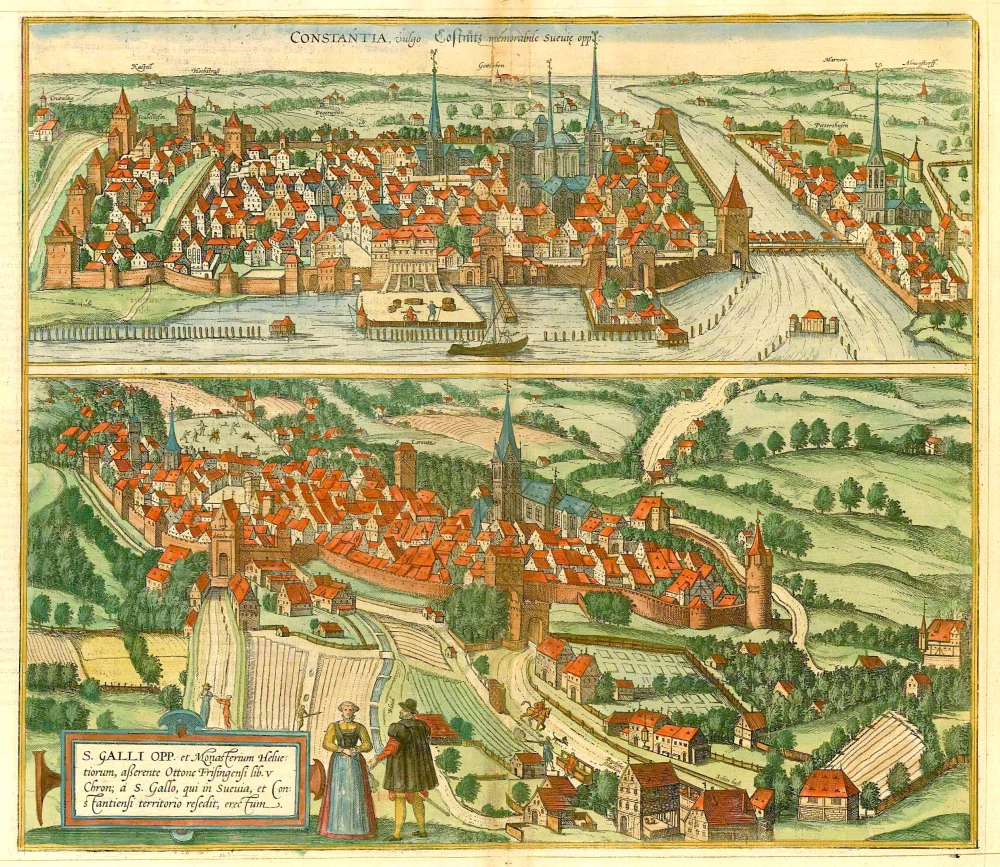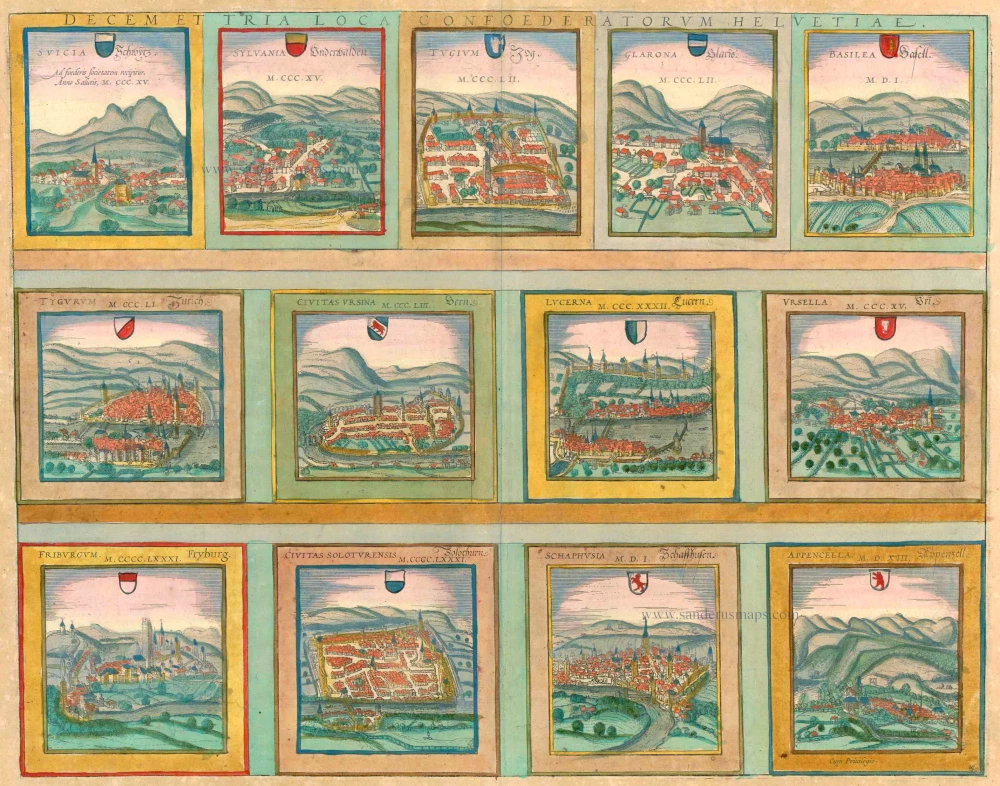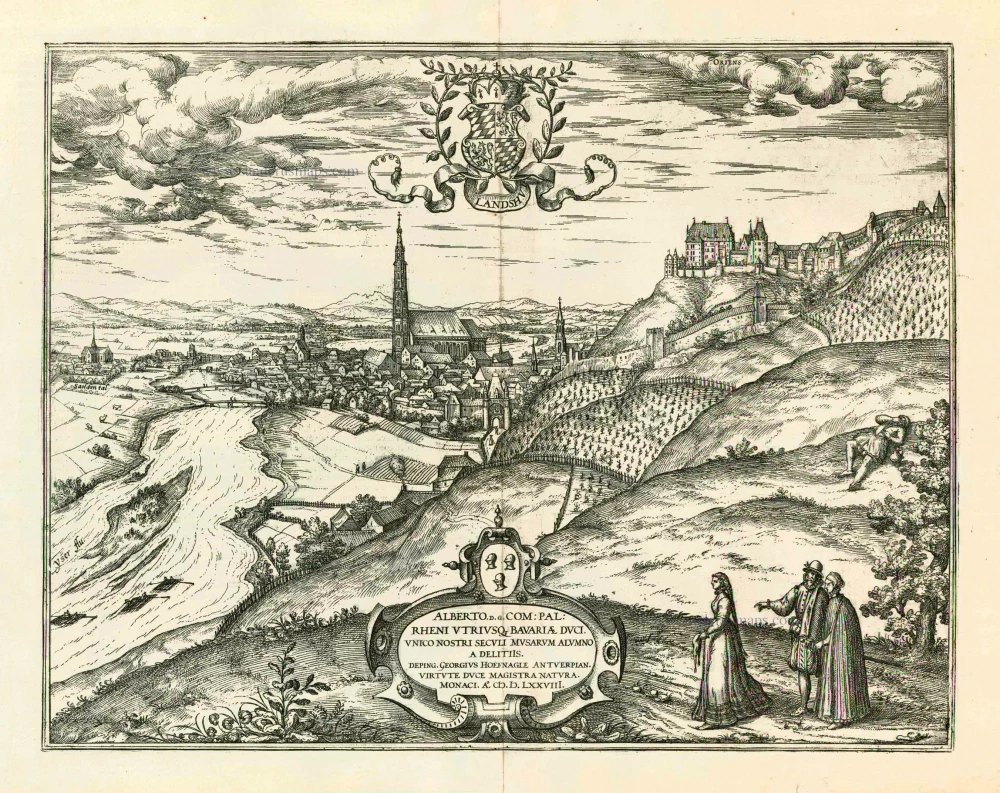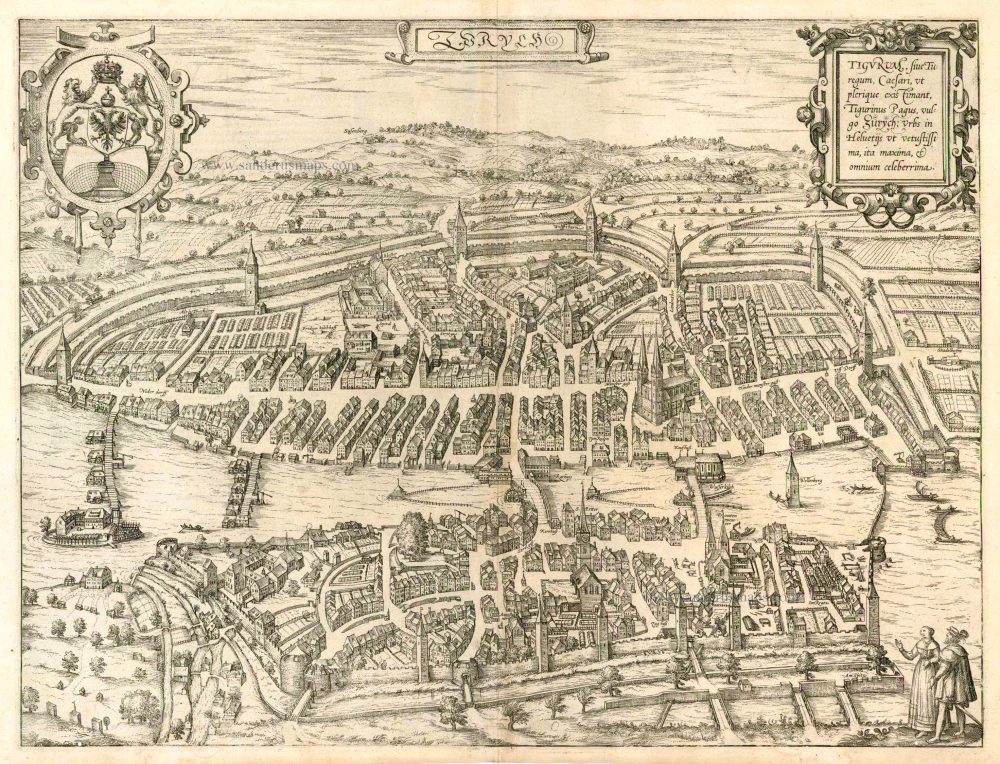Konstanz - Sankt Gallen by Georg Braun and Frans Hogenberg. 1575-1612
CONSTANCE (KONSTANZ)
CAPTION: Constantia, commonly known as Konstanz, a remarkable Swabian town.
COMMENTARY BY BRAUN: "Constance lies at a very charming place on the Swiss side of Lake Constance. It is surely the most excellent of all the towns on this lake at the present time, and is divided into two groups, the one consisting of noble and knightly persons, and the other of merchants and artisans. When one of the common people achieves great wealth and would aspire to become a member of the knightly estate, this is not permitted and he must continue in his standing."
This bird's-eye view shows the city from an ideal viewpoint looking out across Lake Constance. In the 16th century it had a population of about 5,000. In the middle of the harbour is the 14th-century building in which the conclave for the election of Pope Martin V took place during the Council of Constance in 1414-1418. On the right can be seen the originally Romanesque minster dedicated to Our Lady, which was altered in the Gothic style up to the 15th century. For over 1,000 years the see of the former bishopric of Constance was here. The second tall church tower is that of the late Gothic church of St Stephen, which was the town's parish church. The present-day town hall is in the former guild house of the linen weavers dating from the 16th century, which does not stand out from the mass houses but which is close to St Stephen's church.
This view is made after a single-state woodcut in the Überlingen City Archives, printed by Hamma in Constance, 1544.
ST GALLEN
CARTOUCHE: St Gallen, town and monastery in Switzerland: according to the chronicle of Otto of Freising, Book 5, built by St Gallus, who settled in Swabia and in the area of Constance.
COMMENTARY BY BRAUN: "In the beginning the town belonged to a monastery. It lies in the mountains in rather bleak surroundings, but on a charming site with good air and good water and fertile farmland; there is a large population with wealthy and stately burghers who are important producers of linen, and merchants who speak many languages and whose trading activities spread to all the lands of Christendom."
The city of St Gallen is shown in cavalier perspective. The caption S. Lorentz identifies the 15th-century church of St Lawrence. After St Gallen accepted Protestantism under the leadership of the humanist Joachim von Watt (Vadianus) in 1526, this became the main church for the reformed population. The biggest church shown in the plate marks the monastery district of St Gallen. However, today's Baroque monastery district, with its collegiate church, monastery building and library, stands on the site of the Otmar basilica and St Gallus church that are depicted here. It was constructed in the 18th century as a magnificent residence for the abbots of the Benedictine abbey of St Gallen. From 1206 the abbots on St Gallen were imperial princes with a seat and a vote in the imperial Diet of the Holy Roman Empire of the German Nation, and in 1454 the city became the first so-called associate town in the Old Swiss Confederacy.
This view is made after a woodcut by Heinrich Vogtherr the Elder, which appeared in the Schweytzer Chronick of Johannes Stumpff, 1548.
Braun G. & Hogenberg F. and the Civitates Orbis Terrarum.
The Civitates Orbis Terrarum, also known as the 'Braun & Hogenberg', is a six-volume town atlas and the most excellent book of town views and plans ever published: 363 engravings, sometimes beautifully coloured. It was one of the best-selling works in the last quarter of the 16th century. Georg Braun, a skilled writer, wrote the text accompanying the plans and views on the verso. Many plates were engraved after the original drawings of a professional artist, Joris Hoefnagel (1542-1600). The first volume was published in Latin in 1572 and the sixth in 1617. Frans Hogenberg, a talented engraver, created the tables for volumes I through IV, and Simon van den Neuwel made those for volumes V and VI. Other contributors were cartographers Daniel Freese and Heinrich Rantzau, who provided valuable geographical information. Works by Jacob van Deventer, Sebastian Münster, and Johannes Stumpf were also used as references. Translations appeared in German and French, making the atlas accessible to a wider audience.
Since its original publication of volume 1 in 1572, the Civitates Orbis Terrarum has left an indelible mark on the history of cartography. The first volume was followed by seven more editions in 1575, 1577, 1582, 1588, 1593, 1599, and 1612. Vol.2, initially released in 1575, saw subsequent editions in 1597 and 1612. The subsequent volumes, each a treasure trove of historical insights, graced the world in 1581, 1588, 1593, 1599, and 1606. The German translation of the first volume, a testament to its widespread appeal, debuted in 1574, followed by the French edition in 1575.
Several printers were involved: Theodor Graminaeus, Heinrich von Aich, Gottfried von Kempen, Johannis Sinniger, Bertram Buchholtz, and Peter von Brachel, all of whom worked in Cologne.
Georg Braun (1541-1622)
Georg Braun, the author of the text accompanying the plans and views in the Civitates Orbis Terrarum, was born in Cologne in 1541. After his studies in Cologne, he entered the Jesuit Order as a novice, indicating his commitment to learning and intellectual pursuits. In 1561, he obtained his bachelor's degree; in 1562, he received his Magister Artium, further demonstrating his academic achievements. Although he left the Jesuit Order, he continued his studies in theology, gaining a licentiate in theology. His theological background likely influenced the content and tone of the text in the Civitates Orbis Terrarum, adding a unique perspective to the work.
Frans Hogenberg (1535-1590)
Frans Hogenberg was a Flemish and German painter, engraver, and mapmaker. He was born in Mechelen as the son of Nicolaas Hogenberg.
By the end of the 1560s, Frans Hogenberg was employed upon Abraham Ortelius's Theatrum Orbis Terrarum, published in 1570; he is named an engraver of numerous maps. In 1568, he was banned from Antwerp by the Duke of Alva and travelled to London, where he stayed a few years before emigrating to Cologne. He immediately embarked on his two most important works, the Civitates, published in 1572 and the Geschichtsblätter, which appeared in several series from 1569 until about 1587.
Thanks to large-scale projects like the Geschichtsblätter and the Civitates, Hogenberg's social circumstances improved with each passing year. He died as a wealthy man in Cologne in 1590.
Constantia, vulgo Costnitz Memorabile Sueuie Opp. [on sheet with:] S. Galli Opp. et Monasterium Helvetiorum, ...
Item Number: 4113 Authenticity Guarantee
Category: Antique maps > Europe > Germany - Cities
Two antique bird’s-eye views: Konstanz and
Sankt Gallen by Georg Braun and Frans Hogenberg.
Title: Constantia, vulgo Costnitz Memorabile Sueuie Opp. [on sheet with:] S. Galli Opp. et Monasterium Helvetiorum, ...
Date: 1575-1612.
Copper engraving, printed on paper.
Size (not including margins): 360 x 410mm (14.17 x 16.14 inches).
Verso: Latin text.
Condition: Old coloured.
Condition Rating: A.
From: Civitates Orbis Terrarum, ... Part 2. Köln, 1575-1612.
CONSTANCE (KONSTANZ)
CAPTION: Constantia, commonly known as Konstanz, a remarkable Swabian town.
COMMENTARY BY BRAUN: "Constance lies at a very charming place on the Swiss side of Lake Constance. It is surely the most excellent of all the towns on this lake at the present time, and is divided into two groups, the one consisting of noble and knightly persons, and the other of merchants and artisans. When one of the common people achieves great wealth and would aspire to become a member of the knightly estate, this is not permitted and he must continue in his standing."
This bird's-eye view shows the city from an ideal viewpoint looking out across Lake Constance. In the 16th century it had a population of about 5,000. In the middle of the harbour is the 14th-century building in which the conclave for the election of Pope Martin V took place during the Council of Constance in 1414-1418. On the right can be seen the originally Romanesque minster dedicated to Our Lady, which was altered in the Gothic style up to the 15th century. For over 1,000 years the see of the former bishopric of Constance was here. The second tall church tower is that of the late Gothic church of St Stephen, which was the town's parish church. The present-day town hall is in the former guild house of the linen weavers dating from the 16th century, which does not stand out from the mass houses but which is close to St Stephen's church.
This view is made after a single-state woodcut in the Überlingen City Archives, printed by Hamma in Constance, 1544.
ST GALLEN
CARTOUCHE: St Gallen, town and monastery in Switzerland: according to the chronicle of Otto of Freising, Book 5, built by St Gallus, who settled in Swabia and in the area of Constance.
COMMENTARY BY BRAUN: "In the beginning the town belonged to a monastery. It lies in the mountains in rather bleak surroundings, but on a charming site with good air and good water and fertile farmland; there is a large population with wealthy and stately burghers who are important producers of linen, and merchants who speak many languages and whose trading activities spread to all the lands of Christendom."
The city of St Gallen is shown in cavalier perspective. The caption S. Lorentz identifies the 15th-century church of St Lawrence. After St Gallen accepted Protestantism under the leadership of the humanist Joachim von Watt (Vadianus) in 1526, this became the main church for the reformed population. The biggest church shown in the plate marks the monastery district of St Gallen. However, today's Baroque monastery district, with its collegiate church, monastery building and library, stands on the site of the Otmar basilica and St Gallus church that are depicted here. It was constructed in the 18th century as a magnificent residence for the abbots of the Benedictine abbey of St Gallen. From 1206 the abbots on St Gallen were imperial princes with a seat and a vote in the imperial Diet of the Holy Roman Empire of the German Nation, and in 1454 the city became the first so-called associate town in the Old Swiss Confederacy.
This view is made after a woodcut by Heinrich Vogtherr the Elder, which appeared in the Schweytzer Chronick of Johannes Stumpff, 1548.
Braun G. & Hogenberg F. and the Civitates Orbis Terrarum.
The Civitates Orbis Terrarum, also known as the 'Braun & Hogenberg', is a six-volume town atlas and the most excellent book of town views and plans ever published: 363 engravings, sometimes beautifully coloured. It was one of the best-selling works in the last quarter of the 16th century. Georg Braun, a skilled writer, wrote the text accompanying the plans and views on the verso. Many plates were engraved after the original drawings of a professional artist, Joris Hoefnagel (1542-1600). The first volume was published in Latin in 1572 and the sixth in 1617. Frans Hogenberg, a talented engraver, created the tables for volumes I through IV, and Simon van den Neuwel made those for volumes V and VI. Other contributors were cartographers Daniel Freese and Heinrich Rantzau, who provided valuable geographical information. Works by Jacob van Deventer, Sebastian Münster, and Johannes Stumpf were also used as references. Translations appeared in German and French, making the atlas accessible to a wider audience.
Since its original publication of volume 1 in 1572, the Civitates Orbis Terrarum has left an indelible mark on the history of cartography. The first volume was followed by seven more editions in 1575, 1577, 1582, 1588, 1593, 1599, and 1612. Vol.2, initially released in 1575, saw subsequent editions in 1597 and 1612. The subsequent volumes, each a treasure trove of historical insights, graced the world in 1581, 1588, 1593, 1599, and 1606. The German translation of the first volume, a testament to its widespread appeal, debuted in 1574, followed by the French edition in 1575.
Several printers were involved: Theodor Graminaeus, Heinrich von Aich, Gottfried von Kempen, Johannis Sinniger, Bertram Buchholtz, and Peter von Brachel, all of whom worked in Cologne.
Georg Braun (1541-1622)
Georg Braun, the author of the text accompanying the plans and views in the Civitates Orbis Terrarum, was born in Cologne in 1541. After his studies in Cologne, he entered the Jesuit Order as a novice, indicating his commitment to learning and intellectual pursuits. In 1561, he obtained his bachelor's degree; in 1562, he received his Magister Artium, further demonstrating his academic achievements. Although he left the Jesuit Order, he continued his studies in theology, gaining a licentiate in theology. His theological background likely influenced the content and tone of the text in the Civitates Orbis Terrarum, adding a unique perspective to the work.
Frans Hogenberg (1535-1590)
Frans Hogenberg was a Flemish and German painter, engraver, and mapmaker. He was born in Mechelen as the son of Nicolaas Hogenberg.
By the end of the 1560s, Frans Hogenberg was employed upon Abraham Ortelius's Theatrum Orbis Terrarum, published in 1570; he is named an engraver of numerous maps. In 1568, he was banned from Antwerp by the Duke of Alva and travelled to London, where he stayed a few years before emigrating to Cologne. He immediately embarked on his two most important works, the Civitates, published in 1572 and the Geschichtsblätter, which appeared in several series from 1569 until about 1587.
Thanks to large-scale projects like the Geschichtsblätter and the Civitates, Hogenberg's social circumstances improved with each passing year. He died as a wealthy man in Cologne in 1590.




